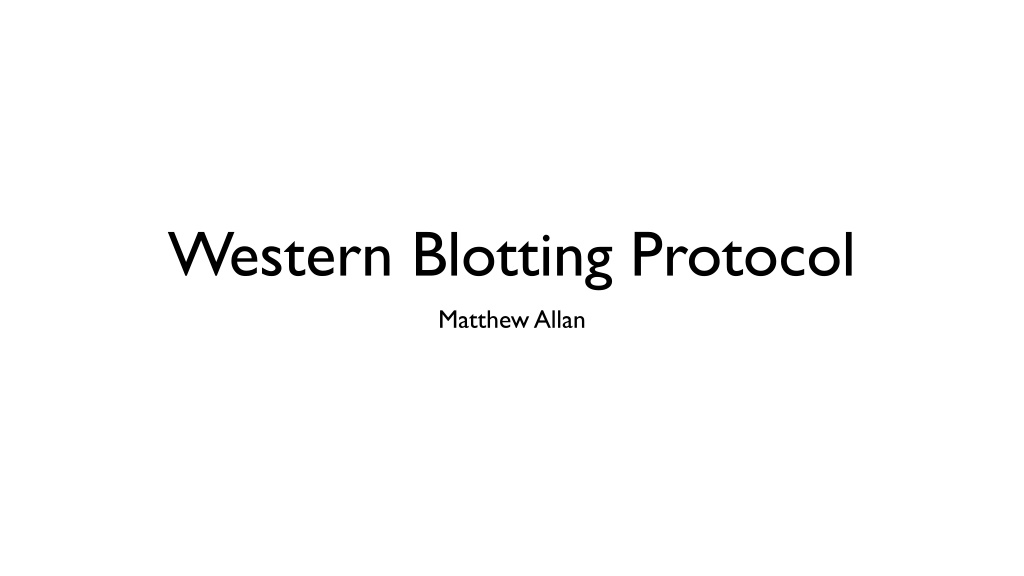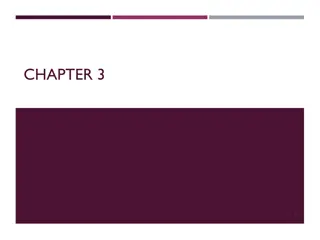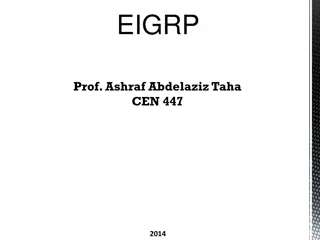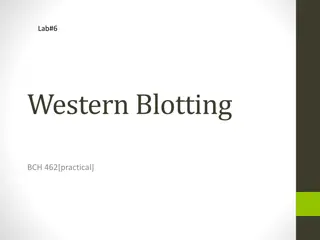Western Blotting Protocol by Matthew Allan
This Western Blotting Protocol by Matthew Allan covers detailed steps from preparing protein samples to imaging results. It includes making a polyacrylamide gel, loading protein samples, running the gel, transferring to a membrane, membrane stacking, blocking, antibody staining, chemiluminescent treatment, and imaging. Follow these steps for successful Western blot analysis.
Uploaded on Sep 27, 2024 | 0 Views
Download Presentation

Please find below an Image/Link to download the presentation.
The content on the website is provided AS IS for your information and personal use only. It may not be sold, licensed, or shared on other websites without obtaining consent from the author.If you encounter any issues during the download, it is possible that the publisher has removed the file from their server.
You are allowed to download the files provided on this website for personal or commercial use, subject to the condition that they are used lawfully. All files are the property of their respective owners.
The content on the website is provided AS IS for your information and personal use only. It may not be sold, licensed, or shared on other websites without obtaining consent from the author.
E N D
Presentation Transcript
Western Blotting Protocol Matthew Allan
Western Blotting Protocol I. II. III. Membrane transfer IV. Preliminary Staining V. Cutting membrane VI. Blocking VII. Primary antibody VIII.Secondary antibody IX. Chemiluminescent treatment X. Imaging Prepare protein samples SDS PAGE
I. SDS PAGE 1. Make a polyacrylamide gel 2. Load protein samples into a gel 3. Run gel
Make a polyacrylamide gel 1. Determine gel percent (see chart) 8% to 14% best 2. Clean cassette and ensure sealing 3. Make corresponding resolving gel and stacking gel (the latter without TEMED); add resolving gel to cassette up to the notch 4. Wait 30 minutes or until solidified 5. Add TEMED to stacking gel and add on top of resolving gel 6. Wait 30 minutes or until solidified 7. Remove from cassette; clean up
Load protein samples into a gel 1. Place gel into electrophoresis apparatus; its notch aligns with the notch on the apparatus (short plate faces inwards, spacer plate outwards) 2. Ensure the rear plastic piece fits snugly into apparatus 3. Tighten clamps and ensure both sides of internal chamber are sealed 4. Place apparatus in plastic container 5. Fill middle chamber with running buffer; spill over into larger chamber until lower electrode is covered 6. Pipette loading dye into protein samples (use 1:10 loading dye:protein) the loading dye contains 10x SDS and beta mercaptoethanol 7. Pipette protein samples into corresponding wells, rinsing the tip between each sample by pipetting the buffer through the tip; add a ladder to the penultimate well and loading dye only to the first and last; all wells should be equivolumetric
Run gel 1. Place the top on the electrophoresis apparatus 2. Set the machine for 220 V and run for 40 min 3. Periodically check if machine is still running: ER means something is wrong likely a loose electrical connection 4. Stop it as soon as the loading dye emerges at the bottom of the gel, and don t let it run any further
II. Membrane transfer 1. Set up membrane and gel stack 2. Run electric current 3. Discard all materials except the membrane
Set up membrane and gel stack 1. Clean machine with dd water 2. For four pieces of filter paper, soak them all at once in transferring buffer (20% methanol, 10% 10x transferring buffer) and stack them up; do not touch the middle and use a flat comb to press out trapped air bubbles 3. Soak and add the membrane 4. Trim off the stacking gel, add the resolving the gel, and smooth it out 5. Add four more filter papers as described above 6. Close the machine and place heavy books on top
Run electric current 1. Set the current to 90 mA per gel 2. Let the machine run for 1 hour
Discard all materials except the membrane 1. The filter paper and gel go into the trash 2. NEVER touch the center of the membrane with fingers or gloves; place it into a plastic bin for staining
III. Preliminary staining The first time you run the gel, you stain the gel itself with Commassie Blue to equalize the amount of protein loaded into each well. Stain with Ponceau S for membranes for western blotting to calibrate the amount of protein to add to each well.
III. Preliminary staining Stain with either Ponceau S for membranes for western blotting to calibrate the amount of protein to add to each well
Ponceau S Stain 1. Pour Ponceau S over the membrane in the plastic bin and slosh it around for several seconds, until bands appear 2. Pour out the Ponceau S and wash briefly with ddH2O, but not so much as to remove the Ponceau S 3. Scan the films in to record how much protein is in each lane with the scanner 4. If needed, the membrane can be placed in a protective sleeve of plastic that is cut to size and then stored at 4 degrees
Coomassie Blue Stain 1. Wash the gel with a fixing agent for coomassie blue on the rocking platform for 10 min 2. Pour out the fixing agent and add the commassie blue carefully (it is toxic), then incubate on the rocking platform for 10 min 3. Pour out the commassie blue into the commassie blue waste containers (it cannot go down the drain 4. Add the destain solution and a VWR light dust paper and place on the rocking platform for a variable time, up to overnight, then pour it out 5. Commassie blue gels are not blotted; rather, they determine whether more or less protein should be added to subsequent gels in order to equalize the protein between lanes
IV. Cutting membrane 1. Place membrane in protective sleeve 2. Label regions of interest 3. Cut apart regions of membrane
Place membrane in protective sleeve 1. Cut a piece of the protective plastic sleeve using the paper trimmer and place the membrane inside the sleeve
Label regions of interest 1. Identify the areas of the membrane in which the proteins of interest will be, using the protein ladder as a guide 2. Outline them with a pen, writing through the plastic sleeve, and label each one with the protein of interest and the lane numbers
Cut apart regions of membrane 1. With the membrane in its sleeve, cut apart the outlined regions with paper trimmer 2. Discard the needless regions of the membrane
V. Blocking 1. Wash membrane 2. Incubate with milk solution on rocking platform Milk protein Protein of interest Membrane
Wash membrane 1. Remove each membrane from its plastic sleeve with forceps 2. Place it in a a plastic bin and cover with TBST 3. Rock the membrane back and for 5 mins, until the Ponceau S disappears 4. Carefully pour the TBST into the sink
Incubate with milk solution on rocking platform 1. Cover the membranes with 5% milk solution in TBST 2. Rock on setting 2 for 5 to 10 minutes 3. Take the membranes out of the plastic bins
Heavy variable Light variable V. Primary antibody Light constant Heavy constant 1. Prepare bag with milk and primary antibody 2. Seal membrane into bag 3. Incubate in vertical rotator Unspecific binding Specific binding
Prepare the bag with milk and primary antibody 1. Calculate the correct amount of each primary antibody to add; typical concentrations range from 1:20000 to 1:500 2. Cut out a section of bag film about 5 cm by 10 cm and seal three sides closed 3. Label each bag with the protein to be blotted for 4. Pipette 3 to 4 mL of 5% milk into each bag 5. Go to the antibody freezer with a 2 20 microliter pipette and tips 6. In the freezer, pipette each primary antibody into its corresponding bag, or take the antibody to the lab bench and add it there
Seal membrane into bag 1. Place each membrane in its corresponding bag with forceps 2. Press out the bubbles from each bag 3. Seal the bag closed, leaving enough space for the membrane to move around; press on the bag to ensure there are no holes
Incubate in vertical rotator 1. Tape each bag to the vertical rotator in the refrigerator 2. Start the rotator, and do not adjust the speed 3. Lightly tap each bag to make sure the membranes can float freely
VI. Secondary antibody 1. Wash membrane in TBST 2. Prepare bag with milk and HRP-fused secondary antibody 3. Seal membrane into bag 4. Incubate in vertical rotator
Wash membrane in TBST 1. Cover the membranes with TBST 2. Rock on setting 2 for 10 minutes or setting 3 for 5 minutes 3. Carefully pour the TBST into the sink 4. Repeat steps 1 to 3 twice more
Prepare the bag with milk and secondary antibody 1. Calculate the correct amount of each secondary antibody to add; typical concentrations range from 1:2000 to 1:500 2. Cut out a section of bag film about 5 cm by 10 cm and seal three sides closed 3. Label each bag with the protein to be blotted for 4. Pipette 3 to 4 mL of 5% milk into each bag 5. Go to the antibody freezer with a 2 20 microliter pipette and tips 6. In the freezer, pipette each primary antibody into its corresponding bag; every primary antibody comes from an animal, and every species has a unique heavy constant region; the secondary antibody must match the species that made first antibody for it to bind
Seal membrane into bag 1. Place each membrane in its corresponding bag with forceps 2. Press out the bubbles from each bag 3. Seal the bag closed, leaving enough space for the membrane to move around; press on the bag to ensure there are no holes
Incubate in vertical rotator 1. Tape each bag to the vertical rotator in the refrigerator 2. Start the rotator, and do not adjust the speed 3. Lightly tap each bag to make sure the membranes can float freely
VI. Chemiluminescent treatment 1. Combine the two reagents 2. Add reagent mixture to membranes 3. Align membranes on protective sleeve The HRP, part of the secondary antibody, causes the luminol to glow
Combine luminol and substrate for Western Blot 1. Take out the box of the two reagent bottles from the refrigerator 2. Into a microcentrifuge tube, pipette 100 microliters per membrane of each reagent 3. Put the reagents back in the refrigerator
Add the reagent mixture to the membranes 1. Place the membranes on a piece of Saran Wrap; ensure that the text is readable and the membranes are protein-face-up 2. Pipette-drip the reagent mixture onto each membrane, 200 microliters per membrane, covering evenly and completely 3. Incubate for 1 minute
Align membranes on protective sleeve 1. Move the membranes to an open piece of protective sleeve with forceps 2. Position them such that they are as close as possible without overlapping and right beside the guide strip affixed to the paper 3. Close the sleeve and tape it shut
VI. Imaging 1. Take membranes and film to the darkroom 2. Quickly press film against membrane 3. Repeat as necessary 4. Feed film through developing machine
Take membranes and film to the darkroom 1. Take the film out of the drawer to the left of the SDS PAGE machines 2. Walk to the darkroom in South Frear, flip on the normal light, make sure the exposure bench is clear and the exposure machine is set to Day, open up the black sleeve with the membranes, and then switch to the dark light 3. Wait for the eyes to adjust
Quickly press the film against the membrane 1. Open the film box and remove one piece of film 2. Holding the black paper sleeve open, quickly place the film in position on top of the membranes protective plastic sleeve 3. Keeping one hand on the film at all times to prevent it from moving, place the right hand on the film, remove the left hand from the film, and then, with the left hand, press the black sleeve top flap down onto the film; finally, remove the right hand to allow the sleeve to cover the film entirely 4. Hold for the predetermined amount of time
Repeat as necessary 1. Different regions of the same piece of film can be used for two or more images 2. Different membranes can be imaged 3. Different exposure times, from 2 seconds to 10 minutes, can be used
Feed film through developing machine 1. Once all images have been collected, place each piece of film, one at a time, on the right side feed-in tray 2. The film will automatically be pulled in and developed 3. Once the machine beeps, the next piece of film can be fed in 4. After the final beep, the film has been fully developed and is no longer light-sensitive 5. Ensure that the box of film is closed correctly before turning on the normal light 6. Remove the film from the developing machine 7. Analyze the results
References http://www.bio- rad.com/webroot/web/pdf/lsr/literature/Bulletin_6376.pdf























